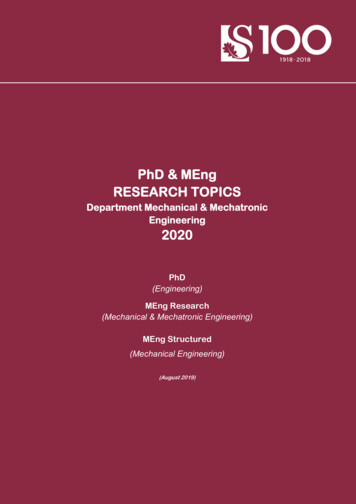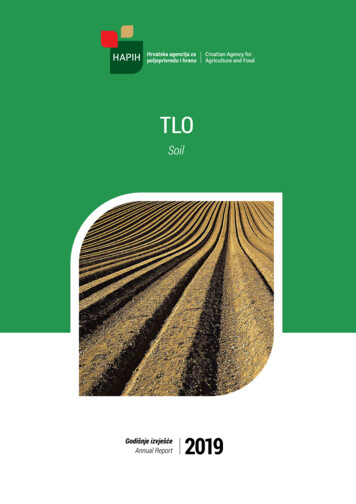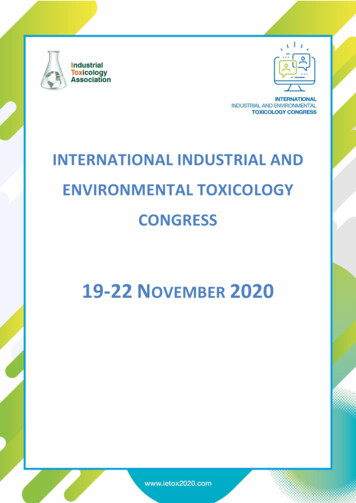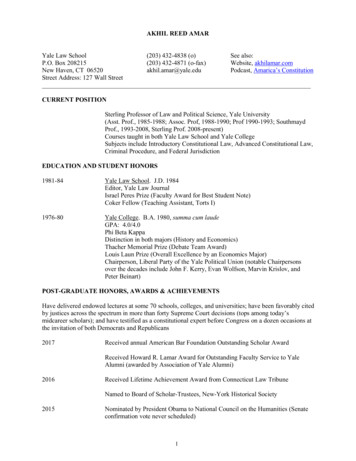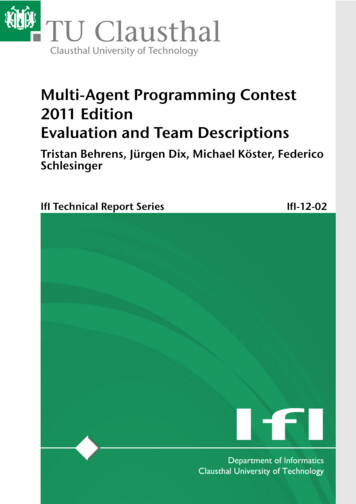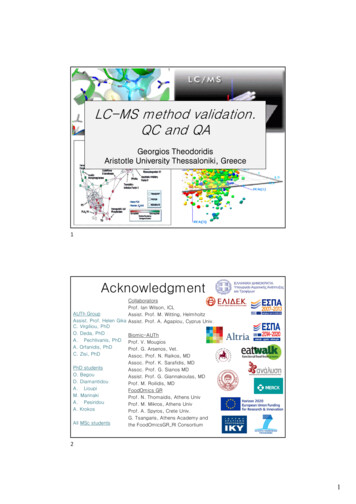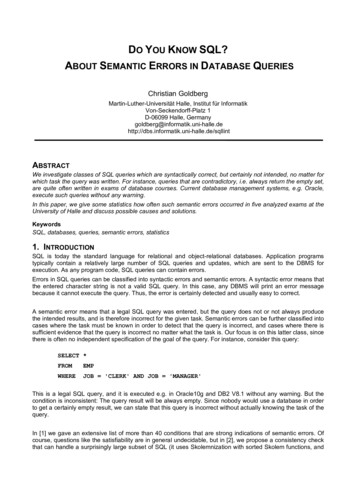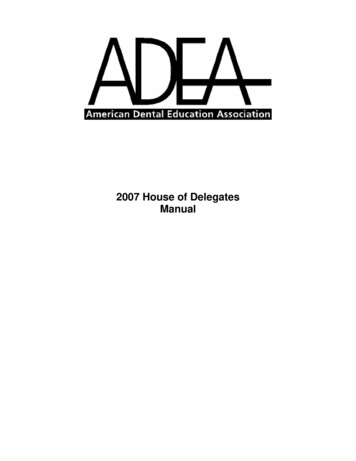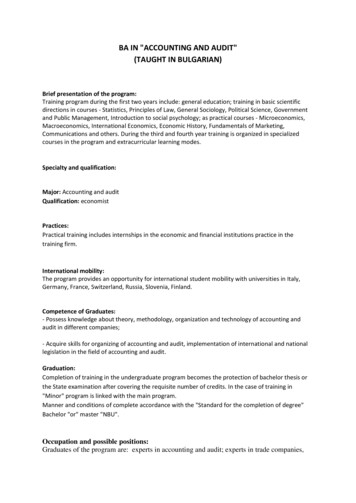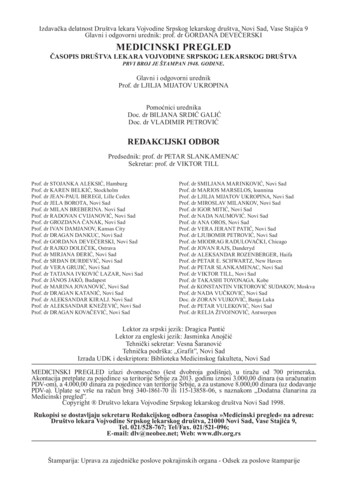
Transcription
Izdavačka delatnost Društva lekara Vojvodine Srpskog lekarskog društva, Novi Sad, Vase Stajića 9Glavni i odgovorni urednik: prof. dr GORDANA DEVEČERSKIMEDICINSKI PREGLEDČASOPIS DRUŠTVA LEKARA VOJVODINE SRPSKOG LEKARSKOG DRUŠTVAPRVI BROJ JE ŠTAMPAN 1948. GODINE .Glavni i odgovorni urednikProf. dr LJILJA MIJATOV UKROPINAPomoćnici urednikaDoc. dr BILJANA SRDIĆ GALIĆDoc. dr VLADIMIR PETROVIĆREDAKCIJSKI ODBORPredsednik: prof. dr PETAR SLANKAMENACSekretar: prof. dr VIKTOR TILLProf. dr STOJANKA ALEKSIĆ, HamburgProf. dr KAREN BELKIĆ, StockholmProf. dr JEAN-PAUL BEREGI, Lille CedexProf. dr JELA BOROTA, Novi SadProf. dr MILAN BREBERINA. Novi SadProf. dr RADOVAN CVIJANOVIĆ, Novi SadProf. dr GROZDANA ČANAK, Novi SadProf. dr IVAN DAMJANOV, Kansas CityProf. dr DRAGAN DANKUC, Novi SadProf. dr GORDANA DEVEČERSKI, Novi SadProf. dr RAJKO DOLEČEK, OstravaProf. dr MIRJANA ĐERIĆ, Novi SadProf. dr SRĐAN ĐURĐEVIĆ, Novi SadProf. dr VERA GRUJIĆ, Novi SadProf. dr TATJANA IVKOVIĆ LAZAR, Novi SadProf. dr JÁNOS JAKÓ, BudapestProf. dr MARINA JOVANOVIĆ, Novi SadProf. dr DRAGAN KATANIĆ, Novi SadProf. dr ALEKSANDAR KIRALJ. Novi SadProf. dr ALEKSANDAR KNEŽEVIĆ, Novi SadProf. dr DRAGAN KOVAČEVIĆ, Novi SadProf. dr SMILJANA MARINKOVIĆ, Novi SadProf. dr MARIOS MARSELOS, loanninaProf. dr LJILJA MIJATOV UKROPINA, Novi SadProf. dr MIROSLAV MILANKOV, Novi SadProf. dr IGOR MITIĆ, Novi SadProf. dr NADA NAUMOVIĆ. Novi SadProf. dr ANA OROS, Novi SadProf. dr VERA JERANT PATIĆ, Novi SadProf. dr LJUBOMIR PETROVIĆ, Novi SadProf. dr MIODRAG RADULOVAČKI, ChicagoProf. dr JOVAN RAJS, DanderydProf. dr ALEKSANDAR ROZENBERGER, HaifaProf. dr PETAR E. SCHWARTZ, New HavenProf. dr PETAR SLANKAMENAC, Novi SadProf. dr VIKTOR TILL, Novi SadProf. dr TAKASHI TOYONAGA. KobeProf. dr KONSTANTIN VIKTOROVIĆ SUDAKOV, MoskvaProf. dr NADA VUČKOVIĆ, Novi SadDoc. dr ZORAN VUJKOVIĆ, Banja LukaProf. dr PETAR VULEKOVIĆ, Novi SadProf. dr RELJA ŽIVOJNOVIĆ, AntwerpenLektor za srpski jezik: Dragica PantićLektor za engleski jezik: Jasminka AnojčićTehnički sekretar: Vesna ŠaranovićTehnička podrška: „Grafit”, Novi SadIzrada UDK i deskriptora: Biblioteka Medicinskog fakulteta, Novi SadMEDICINSKI PREGLED izlazi dvomesečno (šest dvobroja godišnje), u tiražu od 700 primeraka.Akontacija pretplate za pojedince sa teritorije Srbije za 2013. godinu iznosi 3.000,00 dinara (sa uračunatimPDV-om), a 4.000,00 dinara za pojedince van teritorije Srbije, a za ustanove 8.000,00 dinara (uz dodavanjePDV-a). Uplate se vrše na račun broj 340-1861-70 ili 115-13858-06, s naznakom „Dodatna članarina zaMedicinski pregled”.Copyright Društvo lekara Vojvodine Srpskog lekarskog društva Novi Sad 1998.Rukopisi se dostavljaju sekretaru Redakcijskog odbora časopisa »Medicinski pregled« na adresu:Društvo lekara Vojvodine Srpskog lekarskog društva, 21000 Novi Sad, Vase Stajića 9,Tel. 021/528-767; Tel/Fax. 021/521-096;E-mail: dlv@neobee.net; Web: www.dlv.org.rsŠtamparija: Uprava za zajedničke poslove pokrajinskih organa - Odsek za poslove štamparije
Publishing Sector of the Society of Physicians of Vojvodina of the Medical Society of Serbia, Novi Sad, Vase Stajica 9,Editor-in-Chief Prof GORDANA DEVECERSKI, MD, PhDMEDICAL REVIEWJOURNAL OF THE SOCIETY OF PHYSICIANS OF VOJVODINA OF THE MEDICAL SOCIETY OF SERBIATHE FIRST ISSUE WAS PUBLISHED IN 1948Editor-in-Chief ProfLJILJA MIJATOV UKROPINA, MD, PhDAssistants to the Editor-in-ChiefAssist. Prof BILJANA SRDIC GALIC, MD, PhDAssist. Prof VLADIMIR PETROVIC, MD, PhDEDITORIAL BOARDPresident: Prof PETAR SLANKAMENAC, MD, PhDSecretary: Prof VIKTOR TILL, MD, PhDProf. STOJANKA ALEKSIĆ, MD, PhD, HamburgProf. KAREN BELKIĆ, MD, PhD, StockholmProf. JEAN-PAUL BEREGI, MD, PhD, Lille CedexProf. JELA BOROTA, MD, PhD, Novi SadProf. MILAN BREBERINA, MD, PhD. Novi SadProf. RADOVAN CVIJANOVIĆ, MD, PhD, Novi SadProf. GROZDANA ČANAK, MD, PhD, Novi SadProf. IVAN DAMJANOV, MD, PhD, Kansas CityProf. DRAGAN DANKUC, MD, PhD, Novi SadProf. GORDANA DEVEČERSKI, MD, PhD, Novi SadProf. RAJKO DOLEČEK, MD, PhD, OstravaProf. MIRJANA ĐERIĆ, MD, PhD, Novi SadProf. SRĐAN ĐURĐEVIĆ, MD, PhD, Novi SadProf. VERA GRUJIĆ, MD, PhD, Novi SadProf. TATJANA IVKOVIĆ LAZAR, MD, PhD, Novi SadProf. JÁNOS JAKÓ, MD, PhD, BudapestProf. MARINA JOVANOVIĆ, MD, PhD, Novi SadProf. DRAGAN KATANIĆ, MD, PhD, Novi SadProf. ALEKSANDAR KIRALJ, MD, PhD, Novi SadProf. ALEKSANDAR KNEŽEVIĆ, MD, PhD, Novi SadProf. DRAGAN KOVAČEVIĆ, MD, PhD, Novi SadProf. SMILJANA MARINKOVIĆ, MD, PhD, Novi SadProf. MARIOS MARSELOS, MD, PhD, loanninaProf. LJILJA MIJATOV UKROPINA, MD, PhD, Novi SadProf. MIROSLAV MILANKOV, MD, PhD, Novi SadProf. IGOR MITIĆ, MD, PhD, Novi SadProf. NADA NAUMOVIĆ, MD, PhD, Novi SadProf. ANA OROS, MD, PhD, Novi SadProf. VERA JERANT PATIĆ, MD, PhD, Novi SadProf. LJUBOMIR PETROVIĆ, MD, PhD, Novi SadProf. MIODRAG RADULOVAČKI, MD, PhD, ChicagoProf. JOVAN RAJS, MD, PhD, DanderydProf. ALEKSANDAR ROZENBERGER, MD, PhD, HaifaProf. PETAR E. SCHWARTZ, MD, PhD, New HavenProf. PETAR SLANKAMENAC, MD, PhD, Novi SadProf. VIKTOR TILL, MD, PhD, Novi SadProf. TAKASHI TOYONAGA, MD, PhD, KobeProf. KONSTANTIN VIKTOROVIĆ SUDAKOV, MD, PhD, MoscowProf. NADA VUČKOVIĆ, MD, PhD, Novi SadAssist. Prof. ZORAN VUJKOVIĆ, MD, PhD, Banja LukaProf. PETAR VULEKOVIĆ, MD, PhD, Novi SadProf RELJA ŽIVOJNOVIĆ, MD, PhD, AntwerpenProof-reading for Serbian Language: Dragica PantićProof-reading for English Language: Jasminka AnojčićTechnical Secretary: Vesna ŠaranovićTechnical Support: ”Grafit” Novi SadUDK and descriptor prepared by: the Library of the Faculty of Medicine, Novi SadMEDICAL REVIEW is published two-monthly (six double issues per a year) in the circulation of 700copies. Advance payment for individuals from the territory of Serbia for the year 2013 is 3,000.00 dinars(the VAT being calculated in) and 4,000.00 dinars for the individuals outside the territory of Serbia, and8,000.00 dinars ( the VAT) for the institutions. The payments are to be made to the account number 3401861-70 or 115-13858-06, with the remark ”Additional membership fee for the Medical Review”.Copyright Društvo lekara Vojvodine Srpskog lekarskog društva Novi Sad 1998.The manuscripts are to be submitted to the secretary of theEditorial Board of the journal ”Medical Review” to the following address:Društvo lekara Vojvodine Srpskog lekarskog društva, 21000 Novi Sad, Vase Stajića 9,Tel. 021/528-767; Tel/Fax. 021/521-096;E-mail: dlv@neobee.net; Web: www.dlv.org.rsPrinted by: Department for Joint Affairs of Provincial Authorities - Sector for Printing
Novi SadMEDICINSKI PREGLEDČASOPIS DRUŠTVA LEKARA VOJVODINE SRPSKOG LEKARSKOG DRUŠTVAVase Stajića 9SrbijaMed Pregl 2013; LXVI (3-4): 113-204. Novi Sad: mart-april.SAD R Ž A JUVODNIKKsenija Božić i Gordana Mišić PavkovEPILEPSIJA I AGRESIJA: PREDRASUDE I ČINJENICE. 117-119ORIGINALNI NAUČNI RADOVIVladimir Ristić, Mirsad Maljanović, Iva Popov, Vladimir Harhaji i Vukadin MilankovPOVREDE TETIVE ČETVOROGLAVOG MIŠIĆA BUTA. 121-125Biljana Lazović, Mirjana Zlatković Švenda, Sanja Mazić, Zoran Stajić i Marina ĐelićANALIZA ELEKTROKARDIOGRAMA KOD PACIJENATA SA HRONIČNOM OPSTRUKTIVNOM BOLESTI PLUĆA 126-129Nenad Petković, Siniša Ristić, Milan Stošović i Ljubica ĐukanovićRAZLIKE U ODGOVORU BOLESNIKA LEČENIH HEMODIJALIZAMA NA HUMANI REKOMBINOVANIERITROPOETIN. 130-137STRUČNI ČLANCIBogoljub Mihajlović, Jadranka Dejanović, Bojan Mihajlović, Dušan Popović, Milica Panić i Ilija BjeljacVOJVODINASKOR – LOKALNI SISTEM ZA EVALUACIJU KARDIOHIRURŠKOG OPERATIVNOG RIZIKA.Gordana Kozarov, Tanja Marjanović Milošević i Boško VukšićMERENJA NUHALNE TRANSLUCENCIJE DOPRINOS 3D/4D ULTRAZVUKA.Duška Blagojević, Bojan Petrović, Dejan Marković, Sanja Vujkov i Ivana Demko RihterOČUVANJE VITALITETA PULPE NAKON TRAUME STALNIH ZUBA.Kosana Stanetić i Gordana TešanovićUTICAJ ŽIVOTNOG DOBA I DUŽINE RADNOG STAŽA NA NIVO STRESA I SINDROMA SAGOREVANJA NA POSLUMirjana Miljković, Marija Stojiljković i Olivera RadulovićINFORMISANOST, STAVOVI I UPOTREBA DIJETETSKIH SUPLEMENATA KOD STUDENATA UNIVERZITETAU NIŠU (SRBIJA).Sofija Đorđević, Aleksandra Dickov, Sava Pavkov, Vanja Tadić, Ivana Arsić i Ana ŽugićPROCES IZRADE KVALITETNOG FITOPREPARATA NA PRIMERU BILJNOG 6PRIKAZI SLUČAJEVADragana Tegeltija, Aleksandra Lovrenski, Milana Panjković, Jovan Marjanov, Golub Samardžija i Nemanja PejakovićKARCINOM NASTAO U BRANHIJALNOJ CISTI. 177-180Tatjana Krstić, Vojislava Bugarski, Nina Brkić i Biljana ObradovićODNOS MAJKE PREMA DETETOVOJ DIJAGNOZI CEREBRALNE PARALIZE. 181-184Petar Đurić, Zdenka Majster, Verica Stanković Popović, Vesna Maslarević Radović i Nada DimkovićINKAPSULIRAJUĆA PERITONEUMSKA SKLEROZA - PRIKAZ SLUČAJA. 185-188ISTORIJA MEDICINEŽelimir MikićZNAMENITI LEKARI IZ PROŠLOSTI – ORIBAZIJE IZ PERGAMONA. 189-192PRIKAZI KNJIGA. 193-195SAOPŠTENJA REDAKCIJE. 197-200
M E D I C A L R E V I E WJOURNAL OF THE SOCIETY OF PHYSICIANS OF VOJVODINA OF THE MEDICAL SOCIETY OF SERBIANovi SadVase Stajića 9SerbiaMed Pregl 2013; LXVI (3-4): 113-204. Novi Sad: March-April.CO N T E N T SEDITORIALKsenija Božić and Gordana Mišić PavkovEPILEPSY AND AGRRESSION: PREJUDICE AND FACTS. 117-119ORIGINAL STUDIESVladimir Ristić, Mirsad Maljanović, Iva Popov, Vladimir Harhaji and Vukadin MilankovQUADRICEPS TENDON INJURIES. 121-125Biljana Lazović, Mirjana Zlatković Švenda, Sanja Mazić, Zoran Stajić and Marina ĐelićANALYSIS OF ELECTROCARDIOGRAM IN CHRONIC OBSTRUCTIVE PULMONARY DISEASE PATIENTS. 126-129Nenad Petković, Siniša Ristić , Milan Stošović and Ljubica ĐukanovićDIFFERENT RESPONSE TO HUMAN RECOMBINANT ERYTHROPOIETIN IN PATIENTS UNDERGOING HEMODIALYSISTREATMENT. 130-137PROFESSIONAL ARTICLESBogoljub Mihajlović, Jadranka Dejanović, Bojan Mihajlović, Dušan Popović, Milica Panić and Ilija BjeljacVOJVODINASCORE – LOCAL SYSTEM FOR CARDIAC OPERATIVE RISK EVALUATION.Gordana Kozarov, Tanja Marjanović Milošević and Boško VukšićNUCHAL TRANSLUCENCY MEASUREMENT – THE EFFECT OF 3D/4D ULTRASOUND.Duška Blagojević, Bojan Petrović, Dejan Marković, Sanja Vujkov and Ivana Demko RihterPULP VITALITY PRESERVATION AFTER TRAUMATIC DENTAL INJURIES OF PERMANENT TEETH.Kosana Stanetić and Gordana TešanovićINFLUENCE OF AGE AND LENGTH OF SERVICE ON THE LEVEL OF STRESS AND BURNOUT SYNDROME.Mirjana Miljković, Marija Stojiljković and Olivera RadulovićKNOWLEDGE, ATTITUDES AND USE OF DIETARY SUPPLEMENT AMONG STUDENTS OF THE UNIVERSITY OF NIS (SERBIA).Sofija Đorđević, Aleksandra Dickov, Sava Pavkov, Vanja Tadić, Ivana Arsić and Ana ŽugićANUFACTURING PROCESS OF HIGH QUALITY PHYTOPREPARATION ON EXAMPLE OF HERBAL 6CASE REPORTSDragana Tegeltija, Aleksandra Lovrenski, Milana Panjković, Jovan Marjanov, Golub Samardžija and Nemanja PejakovićCARCINOMA DEVELOPING IN A BRANCHIAL CYST. 177-180Tatjana Krstić, Vojislava Bugarski, Nina Brkić and Biljana ObradovićMOTHERS’ RESOLUTION OF THEIR CHILDREN’S DIAGNOSIS OF CEREBRAL PALSY. 181-184Petar Đurić, Zdenka Majster, Verica Stanković Popović, Vesna Maslarević Radović and Nada DimkovićENCAPSULATING PERITOENAL SCLEROSIS – CASE REPORT. 185-188HISTORY OF MEDICINEŽelimir MikićFAMOUS PHYSICIANS FROM THE PAST – ORIBASISUS FROM PERGAMUM. 189-192BOOK REVIEWS.193-195EDITORIAL OFFICE ANNOUNCEMENTS. 197-200
Poštovane kolege,Zadovoljstvo nam je da vas obavestimo da smo započeli sa primenom ASEESTANT programa za onlajn uređivanje i publikovanje časopisa. Zahvaljujući ovom sistemu vaše buduće rukopise moći ćete da prijavite putemveb stranice http://aseestant.ceon.rs/index.php/medpreg/ (videti Uputstvo saradnicima). Osim prijema rukopisa,ASEESTANT podržava celokupan postupak uređivanja, recenziranja, publikovanja i arhiviranja. Radovi ćeautomatski biti proveravani na plagijarizam putem CrossCheck sistema, a biće olakšano i oblikovanje ključnihreči i referenci. Primenom ovog sistema očekujemo poboljšanje kvaliteta našeg časopisa i pozivamo vas daslanjem radova učestvujete u zajedničkom kreiranju narednih brojeva.Prema poslednjem Bibliometrijskom izveštaju Narodne biblioteke Srbije Medicinski pregled ima najvećucitiranost u SCIndeksu i u ISI indeksima u odnosu na ostale medicinske časopise u zemlji i nadamo se da će,se uz vašu pomoć, ovaj trend nastaviti.Glavni i odgovorni urednikProf. dr Ljilja Mijatov-Ukropina
Med Pregl 2013; LXVI (3-4): 117-119. Novi Sad: mart-april.117UVODNIKEDITORIALUniversity of Novi Sad, Medical Faculty1Clinical Centre of VojvodinaDepartment of Neurology2Department of Psychiatry3UvodnikEditorialUDK 616.853:159.942EPILEPSY AND AGRRESSION: PREJUDICE AND FACTSEPILEPSIJA I AGRESIJA: PREDRASUDE I ČINJENICEKsenija BOŽIĆ1,2 i Gordana MIŠIĆ PAVKOV1,3The association between epilepsy, aggression andviolence has been a subject of debate for decades.Early epidemiological studies reporting an increasedincidence of epileptic patients among prisoners anddelinquents have promoted the opinion that epilepticpatients show aggression and tend to express violentbehavior more frequently than the general population[1,2]. This belief has further been strengthened by descriptions of bizarre and stereotypical behaviors during certain types of epileptic seizures, especially seizures originating in the frontal lobe, as well as by thenot infrequent use of epilepsy as a defense strategyfor crime perpetrators.In the 1990s this widely held opinion graduallylost its popularity among experts after severallarge trials had demonstrated that aggressive phenomena, including completely destructive acts,might be induced by epileptic seizures. However,they are extremely rare [3].The results of a recent large Swedish populationstudy reported by Fazel and colleagues in 2011show that epilepsy does not increase the risk ofcriminal offences [4]. The relationship betweenconvictions for violent crime and previously established diagnoses of epilepsy and traumatic brain injury was studied on a sample that comprised thewhole Swedish population followed from 1973 to2009. The study included 22,947 people with epilepsy. The prevalence of convictions for violencewas significantly higher in people with the diagnosis of epilepsy (4.2%) compared with the generalpopulation (2.5%) (OR 1.5, 1.4-1.7). However, thissignificance was lost when individuals with epilepsy were compared with their healthy siblings, whichsuggests that the initial significance was influencedby genetic and/or early environmental factors andnot epilepsy per se.Yet, in spite of the evidence that violence during and between epileptic seizures is rare, negative stereotypes about epilepsy are still prevalent[5]. There is a common misbelief that aggressionand violence are possible or likely during seizuresand that individuals with epilepsy are dangerousand potentially violent, which increases stigmatization and discrimination of these patients.Aggression and Epileptic SeizuresWith regard to the time of occurrence, aggression in persons with epilepsy can occur during aseizure (ictal), before and after a seizure (periictal: pre-and postictal), and between seizures (interictal) [6].Ictal AggressionIctal aggression is very rare. Literature dataabout ictal aggression are sparse and based mainlyon reports of individual patients with frontal ortemporal epileptic lesions [7-10].In a large clinical series that included 5400 patients with epilepsy, aggressive behavior was recorded in 19 patients, and violent behavior duringa seizure was observed in 13 [3]. In most cases aggression and violence during ictal electroencephalographic (EEG) discharges (ictal aggression) wasnon-motivated and unplanned, and in none of thecases was it associated with purposeful movements. In some cases, the patients demonstrateddefensive aggression during another person’s attempts to calm them down during or immediatelyafter the seizure. Direct (directed) ictal aggressionwas extremely rare.When aggressive behavior is a feature of anepileptic seizure, an aggressive act must be accompanied by typical characteristics of a seizure:a seizure starts suddenly without provocation,lasts a short time (1-3 minutes) and ends abruptlywith a violent act which manifests in the contextof impaired consciousness with consequent amne-Corresponding Author: Prof. dr Ksenija Božić, Klinika za neurologiju, 21000 Novi Sad, Hajduk Veljkova 1-7, E-mail: bozick@eunet.rs
Božić K, et al. Epilepsy and agrression: prejudice and facts118AbbreviationsPIP– postictal psychosisEEG– electroencephalographicsia. Witnesses of the seizure may notice the person’sconfusion and fixed, glassy eyes. This aggressivebehavior is completely void of rational elements. Itusually occurs during complex focal seizures withstereotypical phenomena. Generalized seizures, either primary or secondary, may be associated with aviolent act, but directed aggression cannot occurduring convulsions. In order to confirm the epilepticnature of an aggressive act, aggression during epileptic automatism should be documented by videoEEG monitoring.Sometimes, seemingly aggressive and violent behavior may be only physical manifestation of a seizure, such as stereotypical movements in frontal lobeepilepsy or violent muscle jerks in myoclonic seizures, and this behavior may be misinterpreted asdirected aggression.No case where a directed organized attack towards a concrete person or object is a dominantcharacteristic of a seizure has been documentedso far [11].Preictal AggressionDuring the prodromal phase (several minutes,hours or days before the onset of seizure) somenon-specific psychological changes may occur inthe form of irritability, anxiety, depression, dysphoria, aggression, etc., which vary in intensity andcease with the seizure onset. Directed aggressionis possible; however, behavior in this period is nota part of epileptic seizure.Postictal AggressionPostictal aggression is more frequent than ictalaggression. Episodes of postictal aggression last longer, the behavior is out of the person’s character andthere is usually amnesia for the event. Postictal aggression may occur during the postictal automatismor it may be a part of the postictal confusion state,and these two conditions may co-occur. The patientsare confused, their behavior is inappropriate, sometimes aggressive, and more aggressive while othersattempt to calm them down (defensive aggression).Significant violence in this period is rare.Postictal aggression may occur during postictal psychosis (PIP). Definite incidence and prevalence of PIP is not known, it is estimated to occurin the range from 6% to 10% of patients with epilepsy [12,13] and in 18% of patients with pharmacoresistant focal epilepsy [14]. Generally acceptedcriteria for the diagnosis of PIP were establishedby Logsdail and Toone in 1988 [15]. PIP occurscharacteristically after cluster seizures, after a lucid interval (period lasting several hours or daysafter the seizure cessation), with a sudden onset ofpsychotic symptoms of a combined affective picture,often associated with religious delusions and fear ofimpending death. Most postictal psychotic conditions are transitory, last less than a day to severalweeks, and tend to recur in a stereotypical way. Thepatient is conscious and well oriented during the episode, and later has a memory of the episode. Thefear associated with delusions and paranoid ideasduring PIP may lead to violent behavior which maybe hetero- or auto-destructive with frequent suicideattempts [16]. During these conditions there is a significantly higher possibility of directed aggression(23%) compared to acute interictal psychoses (5%)and postictal confusion (1%) [17].Interictal AggressionAggression and violence are much more common outside (between) epileptic seizures, and eventhen the association with epilepsy is questionable.Aggression which is not associated with a seizure is typically manifested as directed and sociallyunderstandable aggression – it is purposeful, coordinated and not stereotypical. Recovery is fast andthere is no confusion. This aggression is often influenced by some events from the person’s surroundings, although the trigger-factor is not alwayseasily perceptible and may last longer (several minutes or longer). Adverse effects of drugs and combined intoxication may lower the threshold of frustration tolerance, and impaired memory is often aconsequence of affect and not of epileptic seizure.A significant risk factor for interictal aggressionis the presence of a structural brain damage. Trauma and encephalitis are associated with a higher incidence of epilepsy; however, a causal relationshipbetween epilepsy and interictal aggression has notbeen established [18]. Lesions of the frontal region,left hemisphere and limbic system are also in a positive correlation with interictal aggression [19]. Predisposing factors for aggressive behavior includecognitive disturbances which frequently accompanybrain injuries [20]. Aggressive disposition is foundparticularly in young men of lower socioeconomicstatus and educational level and of lower level of intellectual functioning with long-term behavioralproblems, whereas epilepsy has not been proved tobe a risk factor for aggressive behavior [21].In addition, aggression may be influenced byinterictal psychopathology; and comorbidity, inthe sense of more frequent affective and schizophrenic disorders in individuals with epilepsy, issignificant. Interictal aggression may be viewed inthe context of antisocial personality disorder resulting from a difficult psychosocial backgroundof the epileptic patient.ConclusionAggressive behavior may occur in different social circumstances and patients with epilepsy are
Med Pregl 2013; LXVI (3-4): 117-119. Novi Sad: mart-april.not immune to the possibility of being involved inan aggressive act. Although certain epidemiological studies report that epilepsy is twice or fourtimes more frequent among prisoners than in thegeneral population, its prevalence is the same as inthe subpopulation with lower socioeconomic status.There is no evidence that aggression and violenceare more frequent among epileptic patients com-119pared to people without epilepsy, and there is noevidence that violence is more frequent in patientswith temporal lobe epilepsy compared to patientswith other types of epilepsy. Ictal aggression is extremely rare, stereotypical, defensive and non-directed. The association between violence, aggression, and epilepsy is multifactorial; they may cooccur in one person without affecting one another.References1. Gunn JC. The prevalence of epilepsy among prisoners.Proc Roy Soc Med 1969;62:60-3.2. Lewis DO, Pincus JH, Shanok SS, et al. Psychomotorepilepsy and violence in a group of incarcated adolescentboys. Am J Psychiatry 1982;139:882-7.3. Delgado-Escueta AV, Mattson RH, King L, et al. Thenature of aggression during epileptic seizures. N Engl J Med1981;305:711-6.4. Fazel S, Lichteinstein P. Grann M, Langstrom N. Riskof violent crime in individuals with epilepsy and traumaticbrain injury: a 35-year Swedish population study. PloS Med2011;8(12):e1001150.5. Kate Collins TB, Camfield PR, Camfield CS, Kay L.People with epilepsy are often perceived as violent. EpilepsyBehav 2007;10:69-76.6. Marsh L, Krauss GL. Aggression and violence in patients with epilepsy. Epilepsy Behav 2000;1:160-8.7. Sumer MM, Atik L, Unal A, et al. Frontal lobe epilepsypresented as ictal aggression. Neurol Sci 2007;28:48-51.8. Shin JJ, Leslie Mazwi T, Falcao G, et al. Directed aggressive behavior in frontal lobe epilepsy: a video-EEG andictal SPECT case study. Neurology 2009;73(21):1804-6.9. Stevens JR, Hermann BP. Temporal lobe epilepsy,psychpatology and violence: the state of evidence. Neurology1981;31:1127-32.10. Brower MC, Price BH. Neuropsychiatry of frontallobe disfunction in violent and criminal behavior: a criticalreview. JNNP 2001;71:720-6.Rad je primljen 3. XII 2012.Prihvaćen za štampu 3. XII 2012.BIBLID.0025-8105:(2013):LXVI:3-4:117-119.11. Treiman DM. In: Principles and Practice of ForensicPsychiatry, 1994; pp 441-50.12. Kanner AM, Satgno S, Kotagal P, et al. Postictal psychotic events during prolonged video-elecntroencephalographic monitoring studies. Arch Neurol 1996;53:258-63.13. Lancman M. Psychosis and periictal confusional states. Neurology 1999;53:S33-8.14. Trimble M, Kaner A, Schmitz B. Postictal psychosis.Epilepsy Behav 2010;19(2):159-61.15. Logsdail SJ, Toone BK. Postictal psychoses: a clinical andphenomenological description. Br J Psychiatry 1988;152:246-52.16. Kanemoto K, Kawasaki J, Mori E. Violence and epilepsy: a close relation between violence and postictal psychosis. Epilepsia 1999;40:107-9.17. Kanemoto K, Kawasaki J, Kawai I. Postictal psychosis: a comparison with acute interictal and chronic psychoses.Epilepsia 1996;37:551-6.18. Stevens JR, Hermann BP. Temporal lobe epilepsy,psychopathology, and vilence: the state of the evidence. Neurology 1981;31:1127-32.19. Grafman J, Schwab K, Warden D, et al. Frontal lobeinjuries, violence and aggression: a report of the VietnamHead Injury Study. Neurology 1996;46:1231-8.20. Vulekovic P, Simic M, Misic-Pavkov G, et al. Traumatic brain injuries: forensic and expertise aspects. Med Pregl2008;61(9-10):471-7.21. Herzberg JL, Fenwick PB. The aethiology of aggression in temporal-lobe epilepsy. Br J Psychiatry 1988;153:50-5.
Med Pregl 2013; LXVI (3-4): 121-125. Novi Sad: mart-april.121ORIGINALNI NAUČNI RADOVIORIGINAL STUDIESGeneral Hospital Subotica, Department of Orthopedics and Traumatology1Clinical Centre of Vojvodina, Novi SadDepartment of Orthopedics and Traumatology2Institute for Children’s Health Care, Novi SadDepartment of Orthopedics and Traumatology3Originalni naučni radOriginal studyUDK 616.748-001-02DOI: 10.2298/MPNS1304121RQUADRICEPS TENDON INJURIESPOVREDE TETIVE ČETVOROGLAVOG MIŠIĆA BUTAVladimir RISTIĆ1, Mirsad MALJANOVIĆ1, Iva POPOV2,Vladimir HARHAJI2 and Vukadin MILANKOV3SummaryIntroduction. The aim of study was to analyze risk factors,mechanisms of injury, symptoms and time that elapsed frominjury until operation of complete quadriceps tendon ruptures.Material and Methods. This retrospective multicenter studyincluded 30 patients operated for this injury, of whom 28 (93.3%)were men. The average age was 53.7 years (18-73). Twenty-sixpatients had reconstruction of unilateral rupture and four ofbilateral one. Results. Eighty percent of them had some riskfactors for rupture of the tendon with degenerative changes.Eight patients had diabetes, seven patients were on renal dialysis, two patients had secondary hyperparathyroidism, fivepatients were obese and two patients had former knee operations. These injuries occurred in 80% following minor traumacaused by falls on stairs, on flat surfaces and squatting. Themost frequent symptoms were: pain, swelling, lack of extension of knee and defect above patella, and three cases wereinitially misdiagnosed. During the first 10 days after injury,acute and chronic ruptures were reconstructed in 22 (73.3%)and 8 patients, respectively. Conclusion. Quadriceps tendoninjuries most often happen to male patients with predisposingconditions in their fifth and sixth decade of life due to trivialtrauma. Patients on renal dialysis are the most vulnerablepopulation group.Key words: Tendon Injuries etiology; Quadriceps Muscle; RiskFactors; Male; DiagnosisIntro
Glavni i odgovorni urednik: prof. dr GORDANA DEVEČERSKI MEDICINSKI PREGLED ČASOPIS DRUŠTVA LEKARA VOJVODINE SRPSKOG LEKARSKOG DRUŠTVA PRVI BROJ JE ŠTAMPAN 1948. . Prof. dr MARIOS MARSELOS, loannina Prof. dr LJILJA MIJATOV UKROPINA, Novi Sad Prof. dr MIROSLAV MILANKOV, Novi Sad Prof. dr IGOR MITIĆ, Novi Sad Prof. dr NADA NAUMOVIĆ. Novi Sad
